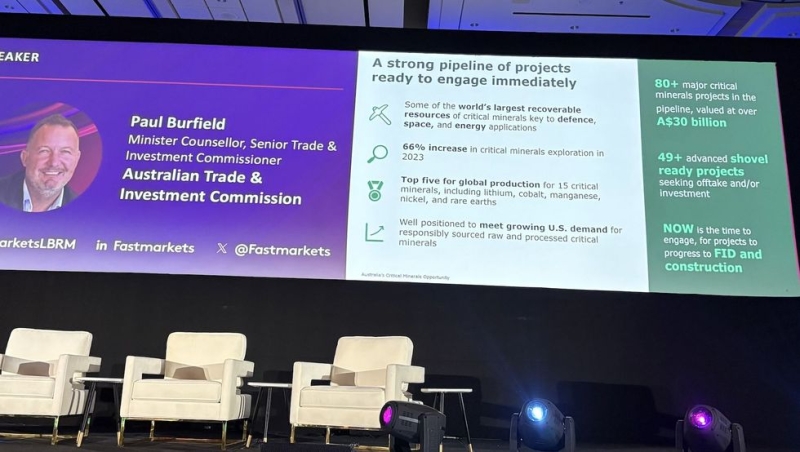Contents
Australia is well positioned to support the near term development of diverse resilience and sustainable US global supply chains, according to Austrade Senior Trade and Investment Commissioner Paul Burfield.
“There are 600 Navy Resource Deposits and more than 350 operating mines across Australia with enormous potential to grow further as much of our country remains under explored,” he said at Fastmarkets’ Lithium Supply & Battery Raw Materials Conference in Las Vegas.
For his part, the commissioner talked about the current Australian resource landscape, highlighting critical minerals.
He also tackled Australia’s growing relationship with the US amidst trade tensions and how he sees the the countries’ partnership progressing.
Australia’s resource sector in a global lens
Burfield warned of vulnerabilities in today’s concentrated supply chains, with critical minerals production and refining largely dominated by a few countries.
The commissioner cited the current global mining industry, referring to how production and refining has been concentrated and “extremely vulnerable” to trade disruption.
He emphasised the risk of price manipulation, export restrictions and instability in markets like lithium, where China currently handles approximately 70 percent of refining.

Slide from Burfield highlighting Australia's vast resource potential.
Image via Georgia Williams.
Australia, he argued, offers a secure, transparent and progressive regulatory landscape.
Backed by world-class workforce expertise and technologies, Australia remains attractive to international partners seeking resilient, diversified sources of supply.
“It doesn't sound like much, but in a sector that is growing at 300 percent, a 10 percent reduction in dependence can be quite significant for this reason, and many others, international allies and like minded partners are increasingly looking to Australia as a reliable and secure supplier permits that they need to grow issues in the future.”
National strengths and industry momentum
The commissioner regarded Australia’s workforce and a deep venture, world class engineering, technology and support technology companies as essential contributors to its competitive advantage.
“In fact, you'll hear accents like mine and many that are much higher across the boardrooms of most of the world's mining and engineering companies,” he said.
According to him, Australia’s mining, engineering and technology sector contributes a quarter of a trillion dollars to its overall economy. These also employ over 1.1 million people in Australia.
Metals-wise, he said that the country plays a role in essential defense, advanced technology and energy security as the top producer of bauxite, lithium and rutile.
He added that Australia is among the top five producers of cobalt, manganese and rare earths like tasman, zircon and zinc.
A stable political system, a reliable and transparent regulatory environment, dependable contract legal environment, excellent environmental, social governance structures and supportive government policies, incentives and programs were also cited as Australia’s strengths, saying that it is among the most progressive countries in these aspects.
Government incentives and investments
“The Australian government (continues) to help develop strategically important critical minerals projects by providing targeted and proportionate support de-risk projects and help overcome distortions,” Burfield said.
He mentioned Australia’s critical minerals facility of about AU$4 billion, which he said is probably debt laden.
In April, the Albanese Government made a pledge of an initial investment of AU$1.2 billion in the reserve upon re-election, including through an AU$1 billion increase in the existing critical minerals facility.
“This will take our total investment in the Facility to $5 billion, providing vital support to private sector and international partners with the upfront capital costs of new projects,” the government said.
In addition to this and other financing options, Burfield cited the AU$7 billion critical minerals production tax incentive, which was passed on February 12.
The incentive will provide a refundable tax credit on 10 percent of eligible costs associated with the production of critical minerals and rare earths, aligning with Australia’s goal of developing its critical minerals sector.
Burfield also highlighted the National Reconstruction Fund, which was launched in September 2023.
“(This aims) to drive Australia's ambitions in advanced manufacturing, and has a billion dollar facility eligible for Australian minerals projects.”
Australia-US alliance
In the midst of his presentation, Burfield said that the intent to build a critical minerals reserve is Australia’s “own version of stock market,” similar to the US.
He said that in terms of a relationship with the US, Australia has already established ourselves as a trusted partner.
“This is demonstrated in several ways, particularly through the decision to consider Australia as a domestic source under Title Three of the Defensive Production Act (DPA), allowing Australian companies to be eligible for US government funding to support our manufacturing and industrial based capacities.”
In 2023, Australia was lined up as a “domestic source” under title three of the DPA, a change part of the broader Australia and US security partnership that aims to strengthen supply chains and industrial bases for both countries.
Australia currently produces 29 of the 50 minerals listed on the US critical minerals list, with the ability to supply up to 36.
Burfield said 49 projects have been identified as shovel-ready, pending private investment and off-take agreements. These projects are believed to “help fuel the growth of the US economy, its manufacturing sector and to drive new industries.”
“(Our collaboration (with the US) is built on these resilient, high quality, rural mineral supply chains and our close industry and government tasks,” he continued. “For over 100 years, (the collaboration stood side by side through war, peace and profound global change. So it goes without saying that Australia could commit a strategy which provides an enduring, long term policy framework to grow our critical middle sectors has been built to reflect our shared and mutual interests.”
Burfield assured the public that Australia and the US are working closely to strengthen supply chains to ensure that specific strategic projects get the support that they need.
Towards the end, he said that plans are in place to develop projects, including government awards, joint ventures and binding off takes. Both countries are expecting that these moves will play a crucial role in terms of supply chains for the defense and battery sectors and beyond.
“We’re really pleased to support these ambitions as a country and provide access to the resources that Australia needs to develop national prosperity and national security.”




